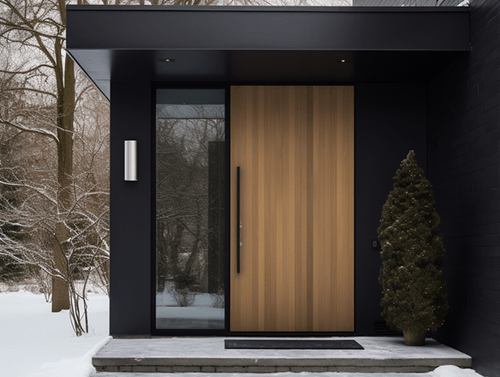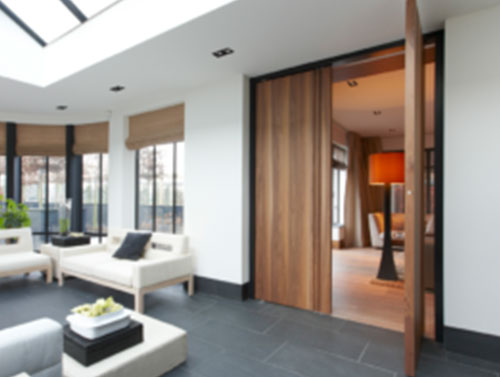When it comes to choosing the right type of door for your home, you have a variety of options available to you. From sliding doors to French doors, there are many styles and designs to choose from. However, two of the most popular options are hinged doors or swing doors and pivot doors. While both types of doors serve the same basic purpose, they have different features, benefits, and drawbacks that you should consider when making your choice.
Swing Doors

Swing Door – Photo Credit: FritsJurgens
Swing doors or hinged doors are the most common type of door that you are likely to encounter. They are typically hinged on one side and open by swinging either inward or outward. They are available in a range of materials and come in a variety of sizes, styles, and colors to suit your home’s aesthetic.One of the main benefits of swing doors is that they are easy to install and operate.
They can be mounted on either side of the doorway and are typically opened and closed by turning a handle or a knob. Additionally, they are widely available and can be purchased at a reasonable price, making them a popular choice for many homeowners and designers.However, swing doors do have some drawbacks that you should consider.
For instance, they require a certain amount of clearance space in order to open and close properly. This can be problematic in tight or cramped spaces, where a door may bump into furniture or other obstacles.
Additionally, swing doors can be more prone to damage from collisions and other impacts, especially if they are made from a more fragile material like glass.
History of Swing Doors

Swing doors are the most common type of door in homes and buildings, and their history can be traced back to ancient civilizations. The earliest known examples of hinged doors are from the Egyptian civilization, where they were used to protect tombs and temples. These early doors were made of wood and were adorned with intricate carvings and decorations.
The use of swing doors spread to other civilizations such as Greece and Rome, where they were used for both interior and exterior spaces. In medieval Europe, hinged doors were primarily used for the entrances of castles and fortresses, where they served as a barrier against invading forces.During the Renaissance period, swing doors underwent a significant transformation in design and style.
They were often decorated with ornate carvings and were used as a means of displaying wealth and status. In the 18th and 19th centuries, hinged doors continued to evolve in both design and function.
The invention of the doorknob in the mid-1800s allowed doors to be opened and closed more easily, and the introduction of new materials such as glass and iron allowed for more intricate designs and greater strength and durability.
Today, swing doors remain a popular choice for both residential and commercial spaces, offering a wide range of design options and practical benefits such as ease of use and increased security.
Pivot Doors

Pivot Door – Photo Credit: FritsJurgens
Pivot doors are a unique type of door that are characterized by pivoting mechanism. Rather than being hinged on one side, pivot doors are mounted on a vertical axis and divides the entryway into two distinct spaces when the pivot door is in its open position. This design makes them ideal for use in wider or more open spaces, as they do not require any clearance space to open or close.
Another benefit of pivot doors is that they are typically more durable than swing doors. Because they do not require hinges or other moving parts, they are less prone to wear and tear over time.
One potential drawback of pivot doors is that they can be more difficult to install and operate than swing doors. They typically require specialized hardware and technical knowledge to mount and operate, which can make them more challenging and costly to install.
Additionally, pivot doors may not be suitable for smaller or more cramped spaces, as they may take up more floor space and require a wider doorway to accommodate their pivoting mechanism.
History of Pivot Doors

Photo Credit: Talking Interior Design
Pivot doors have a long and storied history, dating back to ancient times. Some ancient doors on record are from Iran, Egypt, Greece, and Rome. They could originally be found in ancient stone building constructions, where they were used to hide secret passageways.
An example of very early pivot doors can be found in Gate of all Nations also known as Gate of Xerxes in the ancient city of Persepolis in Iran. Pivoting devices found on the inner corners of all the doors indicate that these doors were hung by pivots that rotated in holes in the sill and lintel and they must have had two-leaved doors, which were possibly made of wood and covered with sheets of ornamented metal.
These early pivot doors were made of wood and were often decorated with ornate carvings and inlaid with metals such as brass and bronze.In the Far East, pivot doors were used extensively in traditional Japanese architecture. The design of these doors was based on the concept of shoji screens, which allowed for the creation of large, open spaces that could be easily partitioned when necessary.
The use of pivot doors in Japanese architecture continues to this day, and they are often used as a means of creating a seamless transition between indoor and outdoor spaces.During the 20th century, pivot doors became increasingly popular in modernist architecture. Architects such as Le Corbusier and Mies van der Rohe incorporated pivot doors into their designs as a means of creating a more fluid and open space.
These doors were often made of glass or metal, and their design was focused on creating a seamless transition between indoor and outdoor spaces.

Photo Credit: Baku MagazineToday, pivot doors remain a popular choice for modern and contemporary architecture. They offer a range of benefits, including increased natural light, greater energy efficiency, and the ability to create a dramatic and striking entrance.
Advantages of a Pivot Door

- Pivot hinges are invisible on pivot doors. This allows for a beautiful aesthetics where the main focus is on the design of the door.
- A pivot door can be made out of a variety of materials as long as the hinges can be mortised inside the door.
- Pivot doors can be used in both interior and exterior applications to complement modern and contempory architecture.
- Pivot doors are easy to install in both new and renovation projects.
- Pivot doors can be frameless and blend seamlessly with the interior architecture.
- Pivot hinges allow architects to specify doors that are made out of heavy materials or that are very large in size. The hinge placement allows the weight of the door to be transferred vertically to the ground so by using the proper pivot system, a pivot door can also weigh up to 500 kgs.
- A pivot door can offer a variety of features such as self-closer, hold positions, damper control, and latch control.
- No matter how large and heavy, with the right type of pivot hinge, a pivot door can be opened and closed with the touch of a finger.
- Pivot doors provide a high level of resistance to forced entry since they don’t have exposed hinges.
- Pivot doors can be equipped with multi-point locking system to further enhance their security.
Choosing the Right Option for Your Home

Ultimately, the choice between swing doors and pivot doors comes down to personal preference and the needs and requirements of your home. If you are looking for an affordable and easy-to-install option, swing doors may be the best choice for you. However, if you are looking for a more durable and stylish door that will stand the test of time, pivot doors may be the better option.
No matter what type of door you choose, it is important to consider the design, style, and finish of your door, as well as its durability, security, and energy efficiency. By taking the time to consider these factors, you can ensure that you choose the best door for your home, one that will provide you with years of security, functionality, and beauty.
Conclusion
Choosing between a swing door and a pivot door for your home ultimately comes down to personal preference and practical considerations. Swing doors offer traditional, classic charm and are easier to install, while pivot doors are a more modern and architectural option that can provide more space and stability. Regardless of which type of door you choose, it is essential to consider factors such as available space, door dimensions, and the door’s intended use before making your final decision. Whether you opt for a swing door or a pivot door, both offer a range of benefits and design options, and both can provide the durability and security that you need. By carefully weighing the pros and cons of each type of door, you can make an informed decision that will provide you with the best solution for your specific needs.






